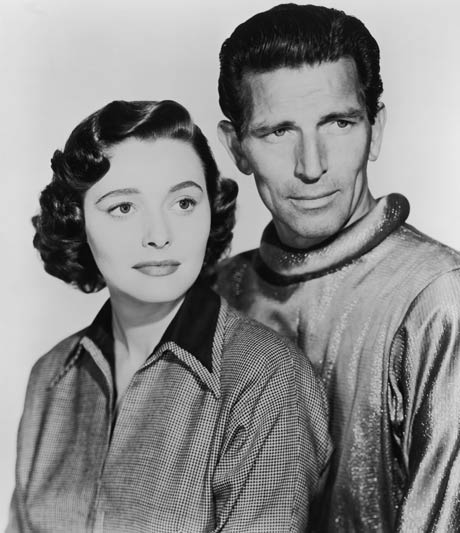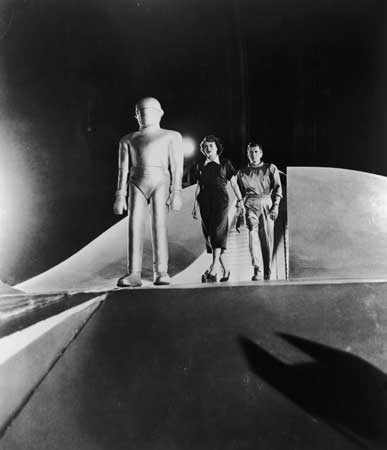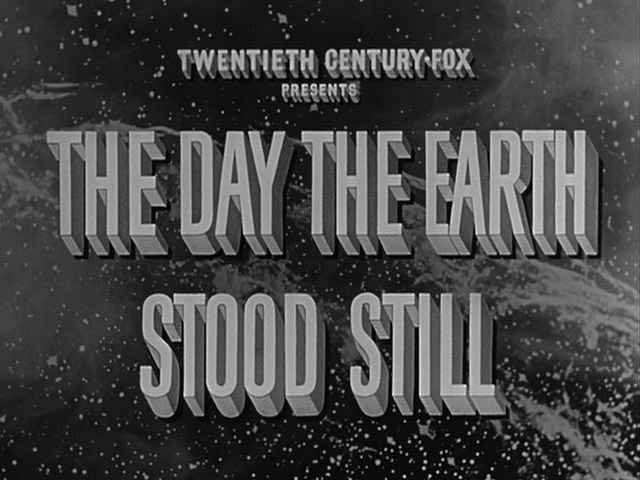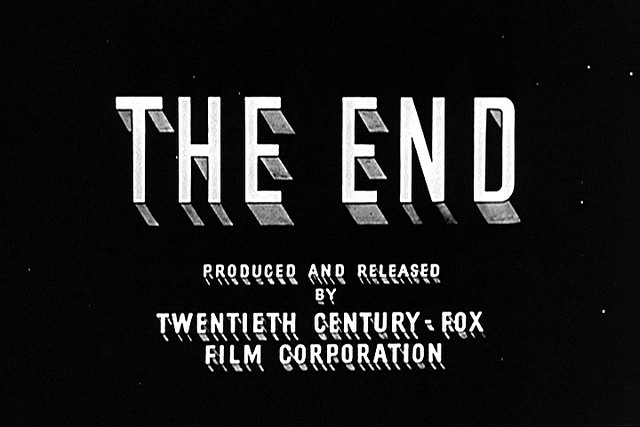60 Years Later, Who Got The Message?
The Day The Earth Stood Still, Resonant Still
The Movie: Origins Of a Classic
Shot, much as Casablanca was, as medium-budget output with a tight schedule, The Day The Earth Stood Still, released 60 years ago this month in 1951, features English actor Michael Rennie, in his first American movie role, as visiting Alien Klaatu, who arrives on Earth as an emissary from a federation of other worlds, only to be shot down by soldiers called out to protect the nation’s Capital, where the alien spacecraft lands. Even the towering robot Gort, able to vaporize objects both living and inanimate with a deadly ray emanating from his eyeslots, cannot prevent Klaatu’s capture. Eventually escaping from military confinement, Klaatu rents a room in a Washington boarding house where the relationship that develops between himself and war-widow Helen Benson (Patricia Neal) and her son Bobby (Billy Gray) may be the difference between Earth’s survival or total destruction.
The publishers of Astounding Science Fiction were paid $1,000 for the film rights to the story by Harry Bates, "Farewell to the Master.” Bates received half of the money as his payment.
The Day the Earth Stood Still was a major motion picture for 20th Century-Fox that presented an adult theme in a serious manner. The movie is often credited with prompting a surge in science fiction movie production during the 1950s.
The original trailer for The Day The Earth Stood Still (1951)Spencer Tracy had read the script and wanted to play the part of Klaatu, but the producer felt he was too well known for the audience to accept him as an alien from another planet. Claude Rains was then considered for the part, but he was tied up performing in a play on Broadway. Finally, Darryl F. Zanuck, the head of 20th Century-Fox, recommended Michael Rennie, an actor he had recently seen performing in London. This was Rennie's first American film.
Patricia Neal and Micheal Rennie in a publicity still for The Day The Earth Stood StillPatricia Neal, who plays Helen Benson, went on to win an Oscar in 1963 for her performance in the movie Hud and would become one of the most beloved of American stage and screen actresses for her roles in The Children’s Hour, Breakfast at Tiffany’s, The Miracle Worker, A Face In The Crowd and an Academy Award nominated part in 1968’s The Subject Was Roses. She died of lung cancer on August 8, 2010, at age 84. Her 1988 autobiography, As I Am, documented a tumultuous and tragedy-scarred personal life largely hidden from the public eye during her career.
Frances Bavier, who plays one of the boarders at Mrs. Crockett's boarding house, went on to play Aunt Bee on The Andy Griffith Show.
Klaatu's spaceship was so well conceived that it influenced the look of spaceships in many science fiction movies that followed, and could even fit the description of the craft that some later UFO abductees would claim they had actually seen.
The Day The Earth Stood Still: the aliens arrive, Gort emerges, wreaks havoc on the Army, attempts to save KlaatuTwo aluminum-painted, foam rubber costumes were constructed for the robot, Gort. One suit opened from the back and was used when he was filmed from the front, and the other suit opened from the front and was used when he was filmed from the back. Because of this, the costume looks like it doesn't have a seam.
The radio newscasters shown during the movie were actual newscasters of the day—most notably Drew Pearson—well known for their speaking styles.
Klaatu tells Helen Benson that if he gets into trouble she is to stop Gort from unleashing his tremendous power by saying, "Klaatu barada nikto." This became, and continues to be, one of the most famous lines in the history of science fiction movies.
‘Gort, klaatu barado nikto’: Helen Benson (Patricia Neal) and Gort (Lock Martin) share a moment in The Day The Earth Stood StillWhen the studio sought to obtain military equipment for the movie from the War Department, the producers were told that the script had been rejected and no equipment would be supplied. The studio eventually obtained the needed jeeps, tanks, etc., from the National Guard of Virginia.
Joseph Lockard "Lock" Martin, who played Gort, was the doorman at Grauman's Chinese Theatre in Hollywood. He was chosen to play the part because he was seven feet seven inches tall. Unfortunately, his condition also made him quite weak, and when he had to pick up and carry Patricia Neal a wire from a crane had to be attached to her to make it possible. He could wear the aluminum-painted foam rubber Gort costume for only about 30 minutes at a time, and when an extended shot of him standing at the spaceship was required a fiberglass replica was used.
In 1950, Sam Jaffe, who plays Professor Jacob Barnhardt, was in the film The Asphalt Jungle, for which he won the Academy Award for Actor in a Supporting Role. Early in his life he had studied engineering at Columbia University and been dean of mathematics at the Bronx Cultural Institute. He was well known for his liberal views and, after The Day the Earth Stood Still was released, finally blacklisted for refusing to cooperate with the U.S. government's House on Un-American Activities Committee. Not being able to find work in Hollywood after he was placed on the blacklist, he went back to teaching mathematics until the late 1950s.
Although The Day the Earth Stood Still takes place in Washington D.C. none of the principal actors ever left Hollywood during the shooting of the movie. When Klaatu and Bobby are shown touring Washington, doubles for the actors were used.
The Day The Earth Stood Still: Klaatu, imprisoned in a hospital, tries to explain his mission to send a message to world leaders to live peacefully or be destroyed as a danger to other planets; rebuffed and told to remain put, he opts for another strategy.Robert Wise, the director of The Day the Earth Stood Still, had worked as editor for the movie Citizen Kane before becoming a director. He would eventually direct 39 movies including West Side Story, The Haunting, The Sound of Music, The Sand Pebbles and The Andromeda Strain. Bernard Herrmann, the composer, had already written the musical scores for Citizen Kane and The Magnificent Ambersons, among others, and would go on to write the scores for many more movies including Vertigo, North by Northwest, Journey to the Center of the Earth, Psycho, Cape Fear and Taxi Driver. For more on the music of Bernard Herrmann, notably regarding his work with Hitchcock, see “Herrmann and Hitchcock: The Torn Curtain”; “The Nature of Bernard Herrmann’s Music”; and “Remembering a Colleague” in the June 2010 issue of TheBluegrassSpecial.com.
The studio's Marketing Department suggested that the movie be called The Day the World Stopped. This was changed to The Day the Earth Stood Still by Julian Blaustein, the movie's producer, because he felt it scanned better.
Awards: The Day the Earth Stood Still won the 1951 Golden Globe Award for Best Picture Promoting International Understanding. It was also nominated that year for a Golden Globe Award for Best Original Score.
In 1995 The Day the Earth Stood Still was added to the U.S. National Film Registry by the Library of Congress for being deemed "culturally, historically, or esthetically important.”
Mise-en-scene: Washington D.C. (The spaceship lands in a park near the capitol's Mall. Klaatu is brought to Walter Reed General Hospital. After he escapes, he goes to a boarding house at 1412 Harvard Street, N.W.)
Era: Early 1950s, during the Cold War between the Western Democracies and the Soviet Union.
Gort with Helen Benson (Patricia Neal) and Klaatu (Michael Rennie) exiting the spacecaft. Gort was played by 7’7”Joseph Lockard "Lock" Martin, otherwise a doorman at Grauman's Chinese Theatre in Hollywood. He was chosen to play the part because of his height. Unfortunately, his condition also made him quite weak, and when he had to pick up and carry Patricia Neal a wire from a crane had to be attached to her to make it possible. He could wear the aluminum-painted foam rubber Gort costume for only about 30 minutes at a time. When an extended shot of him standing at the spaceship was required a fiberglass replica was used.Synopsis: A spaceship carrying Klaatu and an indestructible robot, Gort, lands in a park in Washington D.C. After Klaatu is shot by an overeager soldier, the army brings him to Walter Reed Hospital where he is told he must stay despite his insistence on delivering an important message to an assembly of the world's leaders to live peacefully or be destroyed as a danger to other planets. Easily escaping, Klaatu assumes the name of Mr. Carpenter and rents a room in a local boarding house where he meets Helen Benson and her son Bobby.
Bobby, in response to Klaatu's question, replies that the "smartest man in the world" is Professor Barnhardt. Klaatu goes to Barnhardt's and tells him that he, Klaatu, must deliver a message to a meeting of the world's great scientists since the world leaders can't agree to come together. To prove his power he makes everything that relies on electricity in the world "stand still" for 30 minutes. Finally, after being shot again, Klaatu delivers his ultimatum to the world.
Source: Based on a novelette titled "Farewell to the Master,” by Harry Bates, which was originally published in the October 1940 issue of Astounding Science Fiction.
Cast:
Klaatu (Mr. Carpenter): Micheal Rennie
Gort (the robot): Lock Martin
Helen Benson (widow who helps Klaatu): Patricia Neal
Bobby (Mrs. Benson's son): Billy Gray
Tom Stevens (Helen's boyfriend): Hugh Marlowe
Prof. Jacob Barnhardt: Sam Jaffe
Mrs. Crockett (owns boarding house): Edith Evanson
Mrs. Barley (resident of boarding house): Frances Bavier
George Barley (resident): George Brown
Mr. Krull (resident): Olan Soule
Mr. Harley (Secretary to President): Frank ConroyCrew:
Art Direction: Lyle Wheeler, Addison Hehr
Set Decorations: Thomas Little, Claude Carpenter
Editor: William Reynolds, A.C.E.
Costumes: Travilla
Klaatu’s Costume: Perkins Bailey
Sound: Arthur Kirbach, Harry Leonard
Special Effects: Fred Sersen
Screenplay: Edmund H. North
Music: Bernard Herrmann
Director of Photography: Leo Tover, A.S.C.
Producer: Julian Blaustein
Director: Robert Wise
From The Picture Show Man, a comprehensive resource for vintage films, focusing on the history of motion pictures from the beginning of their development in 1890 to the end of 1960. The website was established by Key Light Enterprises and all copy is (c) 2004 Key Light Enterprises, LLC. All Rights Reserved.
***
Harry Bates: The Story
(The 'Master' Behind 'The Day The Earth Stood Still')
By Bob Gay
Astounding Science Fiction, October 1940, published Harry Bates's story 'Farewell To The Master' that was the basis for The Day The Earth Stood StillHarry Bates was born Hiram Gilmore Bates III in 1900. He began working as an editor for the Clayton chain of pulp magazines sometime in the 1920s and it is for his editorial contributions to the science fiction field that he is best remembered. As the founding editor of Astounding Stories of Super-Science, which soon changed its name to the shorter Astounding Stories, Bates was able to change the direction of the science fiction genre.
While the Gernsback magazines, particularly Amazing Stories, featured large doses of "super-science," Bates had his authors focus more on action and story construction. The science aspects of the stories also had to be more plausible and only offered in short doses. That Bates was able to assert such a degree of control is not surprising, since Astounding had a word rate four times higher than the other pulps of the time and the quality of the work he helped to craft is still recognized today. Unfortunately, Bates' editorial vision for Astounding Stories, and the horror magazine, Strange Tales, were not enough to help the Clayton group. Only 34 issues of Astounding Stories, and seven of Strange Tales, were produced before the entire Clayton group went bankrupt in 1933.
Bates wrote a number of stories during his editorial stint for Clayton, most done in collaboration with his assistant editor, Desmond W. Hall, and most of which were published in Astounding Stories under the pen name of H. B. Winter or Anthony Gilmore. After the bankruptcy, he published only a handful more under his own name, some appearing, serendipitously, in the revived Astounding Science Fiction as published by Street & Smith and edited by John W. Campbell. There is no record of any published work appearing after 1952. In fact, Bates later life seems to be a sort of mystery, as there is no record of what he did for a living after 1933, or any indication of his having but the most tenuous contact with the science fiction field after the Clayton group folded. He died, for the most part forgotten by the genre he had helped shape, in 1981.
Outside of his editorial contributions, it is most likely that Bates would be totally forgotten today if it were not for his short story, "Farewell to the Master." Published in the Oct. 1940 issue of Astounding, the story did not even rate a cover blurb, being overshadowed by A.E. Van Vogt's “Slan.” Eventually, the story was made into the film The Day The Earth Stood Still, but the story only formed the basic premise of the film and was changed in many ways.In the original story, astute readers will notice that Gort does not appear, his name in the story is Gnut. The famous phrase, "Klaatu Barada Nikto" is also absent and there is no love interest for Klaatu; that sub-plot was an invention for the film. What most will find revelatory is the ending of the story, which, without giving anything away, is a wonderful twist by Bates on the science fiction conventions of the time and, more than 60 years later, still reflects on the perceptions that are sometimes a shortcoming of our all too human condition.
(c) 2004 by Bob Gay. The complete text of "Farewell To The Master" is online at The Nostalgia League***
The Music: Bernard Herrmann’s Outlandish Concoction
One of Herrmann's most outlandish musical concoctions, The Day The Earth Stood Still features two theremins, three organs, two pianos, two harps, a wild array of percussion, including three timpani, a brass section that includes four tubas, plus a string trio and guitar. Herrmann also employed unusual overdubbing and tape reversal techniques that predated their use in rock music by more than a decade. Dialogue has been removed from this near-four-minute segment in order to highlight Herrmann's score.The science fiction film of the 1950s, complete with flying saucers and intergalactic travelers (either friendly or plain monstrous) is usually regarded as something of a cliché of the time—a reaction perhaps to the quick technical advancement that started around that time. But many of these films had political undertones beneath the thrilling, otherworldly setting. Like all art, they mirror the time in which they were created. The Day the Earth Stood Still from 1951 was such a film—it works well both as an allegory of our time as well as a thrilling piece of science fiction of its time. Unquestionably, the adventurous, intriguing score by Bernard Herrmann adds immeasurably to the movie’s staying power.
When it comes to unusual orchestrations, Herrmann, with his classical training, was a master of going beyond the usual symphony orchestra settings, and those for The Day the Earth Stood Still are no exception. Herrmann opted to use a brass ensemble of trombones, trumpets and tubas with a large percussion section and double pianos and harps, complemented by a church organ and two Hammond organs, electronically amplified violin, cello, bass and guitar, and—most critical to the ultimate impact of his score—a theremin. Patented by Leo Theremin in 1928, this early electronic instrument had not gained much currency in the classical or popular music fields, in part owing to the difficulty of playing it and the availability over time of other new, more easily mastered electronic instruments. Dimitri Shostakovich had used a theremin in his score for the 1931 Soviet film Odna, but Miklos Rózsa pioneered its use in Hollywood in his scores for two 1945 films (Hitchcock’s Spellbound and Billy Wilder’s The Lost Weekend) and in the 1947 Delmer Daves-directed psychological thriller The Red House (starring Edward G. Robinson, with singer Julie London among the cast members).
This then-obscure electronic gizmo features prominently all over the score for The Day The Earth Stood Still, lending an appropriate aura of otherworldliness to the whole enterprise.
Leon Theremin demonstrates his instrumentHerrmann's unique compositional touches are evident in more than the orchestration on the Jay McNeely-conducted re-recording of the soundtrack for the Varese Sarabande label; this is one of those scores that Bernard Herrmann and only Bernard Herrmann could have written. Each note, each passage bears the Herrmann signature. There are moments of the driving, urgent kind the composer trademarked, as well as more atmospheric, calmer passages. Piano and percussion parts both contain numerous driving ostinato passages (the piano use in "Radar" is striking and is somewhat reminiscent of Jerry Goldsmith's use of the instrument in Planet of the Apes seventeen years later) and the rich use of organs enables atmospheres somber and frightening alike. The contrasting textures of the theremin’s eerie high notes and the organ’s sinister low register lend an open, appropriately spacey feel to “Klaatu,” whereas “Gort” features a short but powerful sequence wherein heavy brass chords and timpani are ornamented by arresting theremin glissandos—once again, intriguing writing in a score rife with such cues.
As often is the case with Herrmann, there is no reoccurring thematic material of the normal kind; Herrmann instead bases his music on shorter thematic cells and chord progressions inverted and modulated in various ways. This is described in more detail in the liner notes, but even when reading and listening closely, it's not easy to hear all the musical twists he skillfully inserted in his music to create unity and symmetry. But in truth, strong thematic material is secondary to a score such as this, which in its style carries a personality so strong that it almost makes traditional melodic writing unnecessary. Even though it is turbulent and somewhat malevolent in mood, the score has a captivating beauty about it. The intricate combination of instruments is indicative of Herrmann’s understanding of the shadings and tones at his disposal, and how he could use those to affect or heighten a scene’s mood.
Among the highlights of the CD: a beautiful brass choral in "Arlington" and "Lincoln Memorial." A lovely violin solo in "Rebirth" is memorable as well. But ultimately, the strong "Prelude," with the powerful brass chords and driving ostinatos that return in "Panic" and "Finale," is the most memorable moment —it stands out, even in Herrmann's vast canon.
Bernard Herrmann's 'Concerto Macabre,' from his score for the film Hangover Square. David Buechner (now Sara Davis Buechner) on piano with the New Zealand Symphony Orchestra conducted by James SedaresFor this re-recording. Joel McNeely does (as always) a faithful job conducting Herrmann, and engineer Jonathan Allen captures the music in clear, uncluttered sonics. The whole ensemble was recorded together, to the benefit of the score’s dynamics. Only the theremin had to be recorded separately, owing to the difficulties of playing the instrument completely in tune. Celia Sheen, who is responsible for the theremin work, delivers an admirable performance.
The Day the Earth Stood Still is not particularly easy listening, given its sometimes harsh writing, and it does tend to be rather subdued; still, it’s another interesting chapter in Bernard Herrmann’s oeuvre, in all its otherworldly, awe inspiring grandeur. Unique, arresting and challenging, the soundscape of The Day the Earth Stood Still is central to the film’s staying power, and on its own a wonderful listening experience.—review in part by Adam Andersson, Golden Scores
THE BLUEGRASS SPECIAL
Founder/Publisher/Editor: David McGee
Contributing Editors: Billy Altman, Laura Fissinger, Christopher Hill, Derk Richardson
Logo Design: John Mendelsohn (www.johnmendelsohn.com)
Website Design: Kieran McGee (www.kieranmcgee.com)
Staff Photographers: Audrey Harrod (Louisville, KY; www.flickr.com/audreyharrod), Alicia Zappier (New York)
E-mail: thebluegrassspecial@gmail.com
Mailing Address: David McGee, 201 W. 85 St.—5B, New York, NY 10024
Founder/Publisher/Editor: David McGee
Contributing Editors: Billy Altman, Laura Fissinger, Christopher Hill, Derk Richardson
Logo Design: John Mendelsohn (www.johnmendelsohn.com)
Website Design: Kieran McGee (www.kieranmcgee.com)
Staff Photographers: Audrey Harrod (Louisville, KY; www.flickr.com/audreyharrod), Alicia Zappier (New York)
E-mail: thebluegrassspecial@gmail.com
Mailing Address: David McGee, 201 W. 85 St.—5B, New York, NY 10024










